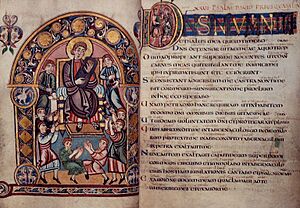Vespasian Psalter facts for kids
The Vespasian Psalter is a very old and special book made in England a long time ago, between the years 750 and 775. It's an illuminated manuscript, which means it's a handwritten book with beautiful pictures and decorations. This book is a psalter, which is a collection of the Book of Psalms from the Bible.
What makes the Vespasian Psalter extra special is that it has the oldest known translation of any part of the Bible into the Old English language. This translation is written right between the lines of the original Latin text. It was likely made in a place called Canterbury in southern England. It's the earliest decorated book from that part of England that we still have today.
The Vespasian Psalter is part of a group of important old books from southern England called the Tiberius group. Other books in this group include the Stockholm Codex Aureus and the Book of Cerne.
Contents
What is the Vespasian Psalter Like?
This ancient book contains the Book of Psalms, along with letters from a saint named St. Jerome, and various hymns and songs. The person who wrote most of the book was also the artist who drew the pictures.
Materials and Writing Style
The book is written in Latin on vellum, which is a type of parchment made from animal skin. The writing style is called Uncial script, which was common in southern England at the time. Important parts, like headings, were written in red using a style called Rustic Capitals. Later, a monk named Eadui Basan added some notes in a different writing style. The Old English translation was written in a smaller, pointed script.
Size and Pages
The Vespasian Psalter is about 23.5 centimeters (about 9 inches) tall and 18 centimeters (about 7 inches) wide. The actual text covers an area of about 17.5 by 13.5 centimeters. The book has 160 pages, called folios.
Decorations and Art
The book has many beautiful decorated letters, called initials. Some of these initials are historiated, meaning they contain small pictures of people or scenes. Others are zoomorphic, meaning they are shaped like animals. You can find these large, decorated initials at the beginning of Psalms 1, Psalm 51, and Psalm 101. This way of dividing the Psalms into three parts was common in books from that time. Smaller decorated letters, sometimes called "antenna" style, mark the start of other Psalms.
The only full-page picture that still exists in the book shows King David with his court musicians. This picture is on page 30 verso. It's possible that this picture was originally at the very beginning of the book. There might have been other decorated pages that are now missing.

History of the Vespasian Psalter
The Vespasian Psalter was created in the middle of the 8th century. It is probably the oldest book in the Tiberius group. The way the Old English translation is written suggests it was made in Canterbury between the years 820 and 850. We know that Eadui Basan, who added notes to the book, was a monk at Christ Church in Canterbury in the early 11th century.
The book was still in Canterbury in 1553. By 1556, it was owned by a man named Sir William Cecil, who lent it to Matthew Parker, who was the Archbishop of Canterbury. Later, in 1599, it became the property of Sir Robert Cotton. He even signed his name on page 12.
In 1702, the book, along with the rest of Sir Robert Cotton's amazing collection of books (known as the Cotton library), became property of the country. In 1753, it became part of the British Museum in London. The book got its name "Vespasian" because it was the first book on a shelf section named after the Roman Emperor Vespasian.
The metal clasps on the book's current cover were added by Sir Robert Cotton.

